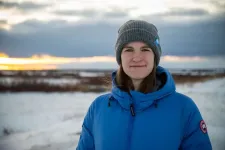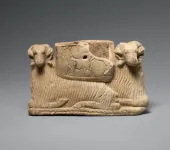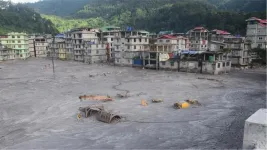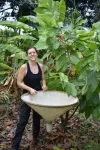(Press-News.org)
Polar bears in Western Hudson Bay have seen their population nearly halved over the last several decades, largely due to dwindling sea ice and limited hunting opportunities, according to the findings of a novel bioenergetic model using data spanning more than 40 years. The findings reveal the relationship between bears’ individual energy needs and environmental limitations in driving population trends, highlighting energy as the central limiting factor behind the decline of a key Arctic apex predator. The Arctic is warming faster than any other region on Earth, leading to significant sea ice loss, ecosystem transformations, and heightened threats to ice-dependent species like polar bears (Ursus maritimus). These animals rely on sea ice to hunt seals, their primary food source, but as ice melts during warmer months, they are forced onto land or into less productive waters, relying on stored energy reserves due to the lack of adequate food sources. Food deprivation caused by changes in seasonal sea ice has been linked to declines in polar bear populations. However, conservation efforts are limited by a lack of data for most polar bear subpopulations and a framework to understand how sea ice loss affects the animals throughout their lives. To investigate the relationship between declining sea ice and polar bear populations, Louise Archer and colleagues compiled population monitoring and capture data collected from polar bears in Western Hudson Bay, Canada, over the last 42 years and developed an individual-based bioenergetic model. The model, grounded in physiological principles, integrates energy acquisition and expenditure – such as feeding, body maintenance, movement, growth, and reproduction – into a unified energy budget spanning an individual bear’s life cycle. The findings show that sea ice loss and resultant feeding limitations were the primary drivers of a ~50% population decline since the mid-1990s, demonstrating how individual energetic constraints shape population-level outcomes. What’s more, Archer et al. note that this framework, although developed for polar bears, is adaptable to other species facing constraints on foraging or energy use due to environmental or human-driven changes, offering broad utility in addressing global change impacts and informing conservation and policy decisions.
END
Polar bear energetic model reveals drivers of polar bear population decline
Summary author: Walter Beckwith
2025-01-30
ELSE PRESS RELEASES FROM THIS DATE:
Socioeconomic and political stability bolstered wild tiger recovery in India
2025-01-30
India, the world’s most populated country, has been successfully working to recover one of the largest, and most iconic, carnivores, the tiger, for decades. Protection, prey, peace, and prosperity have been key factors in the tiger recovery within this densely populated country, according to a new study. According to its authors, success in India offers a rare opportunity to explore the socio-ecological factors influencing tiger recovery more broadly. Earth’s large carnivores, crucial for maintaining ecosystem health, are among the most threatened species, impacted ...
Scratching an itch promotes antibacterial inflammation
2025-01-30
New research uncovers the dual nature of scratching an itch; although it can worsen skin inflammation, it can also boost immune defenses against bacterial infections at the injury site. The findings shed light on a pharmacologically targetable pathway that explains how scratching triggers inflammation, resolving the paradox of scratching as both a harmful pathological process and a beneficial evolutionary adaptation. Scratching is a natural, instinctive response to the sensation of itching, and it plays a central role in many ...
Drivers, causes and impacts of the 2023 Sikkim flood in India
2025-01-30
In a comprehensive analysis, researchers present the divers, causes, and impacts of the catastrophic 2023 Sikkim glacial lake outburst flood (GLOF). The findings stress the urgent need to enhance GLOF hazard assessments and improve prediction and early warning systems as melting glaciers steadily raise the risk of GLOFs in the Himalayan region. South Lhonak Lake – perched at 5200 meters above sea level in the Upper Teesta basin of Sikkim, India – is among the region's largest and most rapidly expanding glacial lakes, posing severe hazards due to its ...
Most engineered human cells created for studying disease
2025-01-30
The most complex engineering of human cell lines ever has been achieved by scientists, revealing that our genomes are more resilient to significant structural changes than was previously thought.
Researchers from the Wellcome Sanger Institute, Imperial College London, Harvard University in the US and their collaborators used CRISPR prime editing to create multiple versions of human genomes in cell lines, each with different structural changes. Using genome sequencing, they were able to analyse the genetic effects of these structural variations on cell survival.
The research, published today (30 January) in Science, ...
Polar bear population decline the direct result of extended ‘energy deficit’ due to lack of food
2025-01-30
U of T Scarborough researchers have directly linked population decline in polar bears living in Western Hudson Bay to shrinking sea ice caused by climate change.
The researchers developed a model that finds population decline is the result of the bears not getting enough energy, and that’s due to a lack of food caused by shorter hunting seasons on dwindling sea ice.
“A loss of sea ice means bears spend less time hunting seals and more time fasting on land,” says Louise Archer, a U of T Scarborough postdoc and lead author of the study.
“This negatively affects the bears’ energy ...
Lifecycle Journal launches: A new vision for scholarly publishing
2025-01-30
(Charlottesville, VA, Jan. 30, 2025) – The Center for Open Science (COS) is excited to announce that Lifecycle Journal, a 3-year research and development pilot on a new model of scholarly communication, is now open for submissions. Lifecycle Journal reimagines scholarly publishing in line with scholarly values of rigor, transparency, sharing, correction, and community evaluation. Lifecycle Journal offers a dynamic, community-driven approach to scholarly publishing, providing a new experience for authors, reviewers, and readers to critically engage with research throughout the entire research lifecycle.
The traditional ...
Ancient DNA analyses bring to life the 11,000-year intertwined genomic history of sheep and humans
2025-01-30
Sheep have been intertwined with human livelihoods for over 11,000 years. As well as meat, their domestication led to humans being nourished by their protein-rich milk and clothed by warm, water-resistant fabrics made from their wool.
Now, an international and interdisciplinary team of researchers led by geneticists from Trinity College Dublin and zooarchaeologists from LMU Munich and the Bavarian State Collections of Natural History (SNSB) has deciphered the prehistoric cultural trajectory of this species by analysing 118 genomes recovered from archaeological bones dating across 12 millennia and stretching from Mongolia to ...
Climate change increases risk of successive natural hazards in the Himalayas
2025-01-30
An international study has investigated the causes and impacts of the devastating flood disaster in the Himalayas in October 2023, which destroyed large areas along and surrounding the Teesta River in Sikkim, India. A research team from nine countries, including researchers from the University of Zurich (UZH), analyzed the complex drivers, causes and consequences of this flood cascade and reconstructed the exact time of its onset.
Massive damage caused by tsunami wave
On 3 October 2023, approximately 14.7 million cubic meters of frozen ...
From bowling balls to hip joints: Chemists create recyclable alternative to durable plastics
2025-01-30
ITHACA, N.Y. – Cornell University researchers have developed a recyclable alternative to a durable class of plastics used for items like car tires, replacement hip joints and bowling balls.
Known as thermosets, this type of plastic boasts a “crosslinked polymer” chemical structure that guarantees longevity but has also made these petrochemical-based materials – which comprise 15%-20% of all polymers produced – impossible to recycle.
“Currently, zero percent of the world’s thermoset materials are recycled – they’re either incinerated ...
Promoting cacao production without sacrificing biodiversity
2025-01-30
The productivity of cacao trees decreases with time, forcing farmers to renew their plantations by either cutting down the old trees or establishing a new crop elsewhere. Frequently, new plantations are established in areas of the forest that are thinned out to accommodate new, young cacao trees. However, this comes with high economic and ecological costs. An alternative approach is to graft highly productive and native cultivars onto the existing older cacao trees. An international team led by scientists of the University of Göttingen found that cacao grafting is a useful measure to rejuvenate cacao plants, increasing their yield and profits with minimal impact on biodiversity. The ...
LAST 30 PRESS RELEASES:
Heart-brain connection: international study reveals the role of the vagus nerve in keeping the heart young
Researchers identify Rb1 as a predictive biomarker for a new therapeutic strategy in some breast cancers
Survey reveals ethical gaps slowing AI adoption in pediatric surgery
Stimulant ADHD medications work differently than thought
AI overestimates how smart people are, according to HSE economists
HSE researchers create genome-wide map of quadruplexes
Scientists boost cell "powerhouses" to burn more calories
Automatic label checking: The missing step in making reliable medical AI
Low daily alcohol intake linked to 50% heightened mouth cancer risk in India
American Meteorological Society announces Rick Spinrad as 2026 President-Elect
Biomass-based carbon capture spotlighted in newly released global climate webinar recording
Illuminating invisible nano pollutants: advanced bioimaging tracks the full journey of emerging nanoscale contaminants in living systems
How does age affect recovery from spinal cord injury?
Novel AI tool offers prognosis for patients with head and neck cancer
Fathers’ microplastic exposure tied to their children’s metabolic problems
Research validates laboratory model for studying high-grade serous ovarian cancer
SIR 2026 delivers transformative breakthroughs in minimally invasive medicine to improve patient care
Stem Cell Reports most downloaded papers of 2025 highlight the breadth and impact of stem cell research
Oxford-led study estimates NHS spends around 3% of its primary and secondary care budget on the health impacts of heat and cold in England
A researcher’s long quest leads to a smart composite breakthrough
Urban wild bees act as “microbial sensors” of city health.
New study finds where you live affects recovery after a hip fracture
Forecasting the impact of fully automated vehicle adoption on US road traffic injuries
Alcohol-related hospitalizations from 2016 to 2022
Semaglutide and hospitalizations in patients with obesity and established cardiovascular disease
Researchers ‘listen in’ to embryo-mother interactions during implantation using a culture system replicating the womb lining
How changing your diet could help save the world
How to make AI truly scalable and reliable for real-time traffic assignment?
Beyond fragmented markets: A new framework for efficient and stable ride-pooling
Can shape priors make road perception more reliable for autonomous driving?
[Press-News.org] Polar bear energetic model reveals drivers of polar bear population declineSummary author: Walter Beckwith




